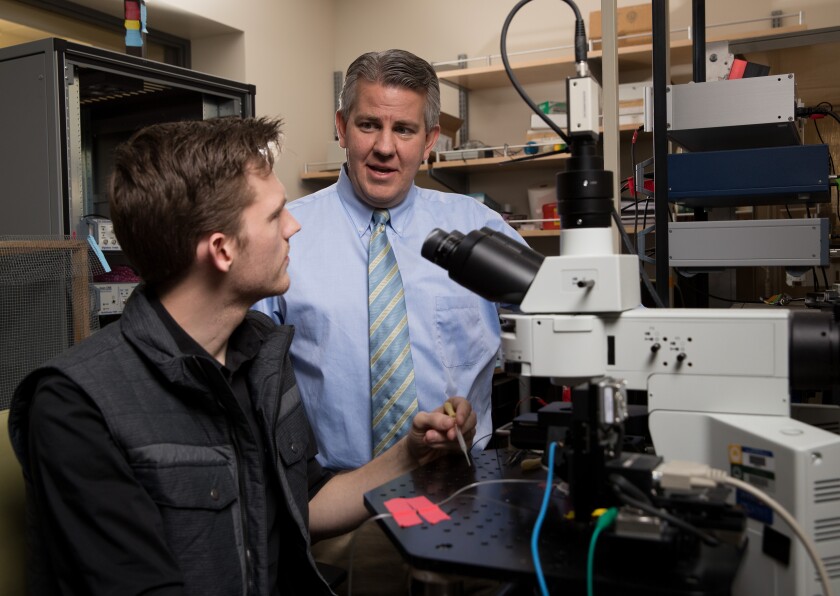Media
Marijuana: Effect in the Brain and Society Issues Regarding Its Use

Press:
BYU Radio InterviewCanadian Broadcast Corporation (CBC): Quirks and Quarks (Episode), Canadian Broadcast Corporation (CBC): Quirks and Quark (Segment)
Exercise Mitigates the Negative Impact of Stress on Memory

Press:
BYU News, The New York Times, Men's Journal, KUTV 2 News, Deseret News
Most people agree that getting a little exercise helps when dealing with stress. A new BYU study discovers exercise under stress also helps protect your memory. The study, newly published in the journal of Neurobiology of Learning and Memory, finds that running mitigates the negative impacts chronic stress has on the hippocampus, the part of the brain responsible for learning and memory. “Exercise is a simple and cost-effective way to eliminate the negative impacts on memory of chronic stress,” said study senior author Jeff Edwards, associate professor of physiology and developmental biology at BYU. The findings reveal exercise is a viable method to protect learning and memory mechanisms from the negative cognitive impacts of chronic stress on the brain. “The ideal situation for improving learning and memory would be to experience no stress and to exercise,” Edwards said. “Of course, we can’t always control stress in our lives, but we can control how much we exercise. It’s empowering to know that we can combat the negative impacts of stress on our brains just by getting out and running.”
A New Target For Marijuana

Press:
BYU News, BYU Radio Interview, Medical News Today, Yahoo News, Canadian Broadcast Corporation (CBC): Quirks and Quarks (Episode), Canadian Broadcast Corporation (CBC): Quirks and Quark (Segment), Top of Mind
Drugs of abuse impact the ventral tegmental area (VTA) of the brain, which is rich in dopamine neurons. Using juvenile and adolescent mice, Jeffrey Edwards and colleagues investigated the effects of tetrahydrocannabinol (THC), the chemical in marijuana responsible for its effects on cognition and behavior, on VTA GABA cells, an understudied inhibitory cell type in the reward system that regulates dopamine levels.
The authors found that a week of daily THC injections, but not a single injection, blocked the recovery of synapses onto VTA GABA cells in the mice. This finding suggests that persistent THC may alter the inhibitory function of these cells, increasing dopamine levels and the rewarding features of marijuana. These GABA neurons may represent a promising new target for treatment of cannabis use disorder, a common condition on the rise in the United States.
Motor Protein In Memory

Press:
BYU News, KSL, Deseret News, Daily Universe
Learning-related plasticity at excitatory synapses in the mammalian brain requires the trafficking of AMPA receptors and the growth of dendritic spines. However, the mechanisms that couple plasticity stimuli to the trafficking of postsynaptic cargo are poorly understood. Here wedemonstrate that myosin Vb (MyoVb), a Ca2+-sensitive motor, conducts spine trafficking during long-term potentiation (LTP) of synaptic strength. Thus, Ca2+-activated MyoVb captures and mobilizes recycling endosomes for AMPA receptor insertion and spine growth, providing a mechanistic link between the induction and expression of postsynaptic plasticity.
TRPV1

Press:
Brown University, Reuters, USA Today
TRPV1 receptors have classically been defined as heat-sensitive, ligand-gated, nonselective cation channels that integrate nociceptive stimuli in sensory neurons. TRPV1 receptors have also been identified in the brain, but their physiological role is poorly understood. Here we report that TRPV1 channel activation is necessary and sufficient to trigger long-term synaptic depression (LTD). Excitatory synapses onto hippocampal interneurons were depressed by capsaicin, a potent TRPV1 channel activator. Our results suggest that, in the hippocampus, TRPV1 receptor activation selectively modifies synapses onto interneurons. Like other forms of hippocampal synaptic plasticity, TRPV1-mediated LTD may have a role in long-term changes in physiological and pathological circuit behavior during learning and epileptic activity.
